Scheme to Attract ‘Star Faculty’ Amid Global Academic Shifts

- 24 Oct 2025
In News:
India is formulating an ambitious new scheme to attract Indian-origin “star faculty” and researchers working in global universities to return and contribute to its domestic research and innovation ecosystem. The initiative, under discussion between the Principal Scientific Adviser’s Office, the Department of Higher Education, and the Departments of Science and Technology (DST) and Biotechnology (DBT), reflects the government’s push to position India competitively in the global race for scientific and academic excellence.
Background: India’s Research Landscape
- India has a strong tradition in science and higher education through premier institutions like the Indian Institutes of Technology (IITs), Indian Institutes of Science Education and Research (IISERs), and national laboratories under the DST and DBT. However, the country faces persistent challenges in retaining and attracting top global talent.
- India’s R&D expenditure remains around 0.7% of GDP, much lower than that of the U.S. (2.8%) and China (2.4%). Coupled with bureaucratic hurdles, modest salaries, and limited research autonomy, these factors have led to a steady outflow of skilled scientists and academics, often referred to as “brain drain.”
- Existing programmes such as the Visiting Advanced Joint Research (VAJRA) Faculty Scheme, Ramanujan Fellowship, and Ramalingaswami Re-entry Fellowship have attempted to link overseas Indian scholars with domestic institutions. However, participation has remained limited, prompting the need for a more comprehensive and long-term mechanism.
Key Features of the Proposed Scheme
The Star Faculty Scheme seeks to attract established Indian-origin researchers with strong academic and scientific credentials to work full-time or for extended periods in Indian institutions.
1. Targeted Recruitment:The initiative will focus on 12–14 strategic areas in science, technology, engineering, and mathematics (STEM) deemed vital for national capacity-building.
2. Financial and Institutional Incentives:Returning scholars are likely to receive substantial one-time set-up grants to establish laboratories and research teams. Institutions like the IITs have expressed support for providing operational flexibility and research autonomy.
3. Red-Carpet Ecosystem:The scheme aims to minimize bureaucratic delays by offering streamlined processes for housing, administrative support, and project funding. Experts emphasize that beyond salaries, a “red-carpet” experience—ease of living and working—is critical to attracting global talent.
4. Collaborative Networks:It will promote inter-institutional linkages between Indian and foreign universities, ensuring long-term collaboration rather than short-term exchanges.
5. Light-Touch Oversight and IP Clarity:A balanced governance framework will ensure academic freedom, transparent intellectual property ownership, and minimal reporting burdens, aligning with global research practices.
Global Context
The initiative comes amid significant shifts in global academia. In the United States, policies like the “Compact for Academic Excellence in Higher Education” under the Trump administration have tightened regulations on international students, race-based admissions, and university autonomy. Critics view these as constraints on academic freedom, prompting uncertainty among foreign faculty—including those of Indian origin.
Simultaneously, Europe is moving to enshrine academic freedom in law, while China and Taiwan continue to expand well-funded recruitment drives to attract overseas researchers. India’s new scheme aims to leverage this shifting academic landscape to bring back its global talent pool.
Structural Challenges
Experts highlight that India’s ability to compete globally will depend on addressing systemic issues:
- Non-competitive pay: A full professor in India earns roughly USD 38,000 annually, compared with USD 130,000–200,000 in the U.S. and USD 100,000 in China.
- Infrastructure gaps: Many universities still lack advanced laboratories and research autonomy.
- Bureaucratic hurdles: Lengthy approval processes discourage international collaboration.
The new programme aims to overcome these through multi-year appointments, flexible tenure, and transparent evaluation mechanisms.
Way Forward
If executed effectively, the Star Faculty Scheme could reverse the brain drain, strengthen India’s knowledge economy, and foster innovation-led growth. It can bridge the gap between academia and industry, promote technology transfer, and develop globally connected research ecosystems.
By offering world-class conditions, trust-based governance, and institutional flexibility, India has the opportunity to reimagine its academic landscape, positioning itself as a global hub for scientific talent and innovation in the 21st century.
Artificial Intelligence and India’s Global Race
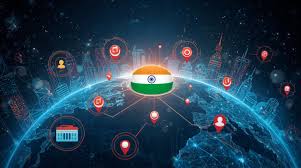
- 28 Sep 2025
In News:
Artificial Intelligence (AI) is reshaping the global technological and economic order, influencing sectors from healthcare to defence. For India, AI represents both a transformative development tool and a strategic domain crucial for economic competitiveness and national security.
India’s Position in the Global AI Landscape
India has entered the AI race with significant momentum, backed by a vast digital ecosystem and growing policy support. The government’s India AI Mission, with an outlay of ?10,372 crore, seeks to enhance AI infrastructure, computing power, and research capacity. With over one billion smartphone users and 20 billion monthly UPI transactions, India offers a data-rich environment that can power AI development at scale.
However, compared to the United States ($20 billion) and China ($30 billion) in AI investments during 2024, India’s funding remains modest. While India boasts a talent base of over 18 million software professionals and has integrated AI into school curricula, it still lags in advanced research output and patent generation.
Opportunities for India’s Development
AI holds immense potential to drive India’s socio-economic transformation:
- Healthcare: AI-assisted diagnostics and predictive models can enhance early disease detection, telemedicine outreach, and epidemic forecasting.
- Education: Initiatives like the Bhashini Project enable real-time language translation, improving accessibility and inclusivity in classrooms and governance.
- Agriculture: AI-driven precision farming and weather-based advisories can help small farmers optimise productivity and manage climate risks.
- Finance: Tools such as “Hello UPI” and AI-based fraud detection can deepen rural financial inclusion and strengthen digital security.
- Disaster Management: States like Odisha employ AI in cyclone prediction and geospatial mapping, showcasing AI’s role in saving lives and resources.
Together, these applications align with India’s broader developmental goals of inclusion, sustainability, and resilience.
Challenges in India’s AI Ecosystem
Despite its promise, India faces structural and institutional constraints:
- Infrastructure Deficit: Limited access to high-end GPUs and slow expansion of data centres constrain computational capacity.
- R&D Weakness: India contributes barely 1.4% of global AI research papers and produces less than 2% of global AI PhDs, reflecting a shallow innovation base.
- Regulatory Lag: The outdated IT Act (2000) continues to govern digital activities, lacking provisions for algorithmic transparency, accountability, and data ethics.
- Talent Gap: The focus on short-term certification courses produces surface-level skills rather than deep AI expertise.
- Geopolitical Pressure: The US, EU, and China lead in developing Large Language Models (LLMs), while India risks remaining a consumer market rather than a producer of foundational AI technologies.
Way Forward
A robust AI ecosystem requires a multi-dimensional approach:
- Strengthen Research and Innovation: Enhance public funding for fundamental AI research and incentivise private R&D.
- Human Capital Development: Expand AI training beyond elite institutions and develop teacher capacity for advanced AI pedagogy.
- Regulatory Reforms: Enact a Digital India Act and an AI-specific ethical charter inspired by the EU AI Act, ensuring safety without stifling innovation.
- Public–Private Collaboration: Establish AI innovation hubs focused on healthcare, agriculture, and sustainability.
- Global Partnerships: Engage with international initiatives and leverage India’s leadership in G20 and BRICS to promote responsible AI governance.
Conclusion
India’s AI trajectory stands at a decisive juncture. With its digital depth, demographic advantage, and policy intent, the country can harness AI to drive inclusive growth and global leadership. Yet, without addressing gaps in research, regulation, and ethics, India risks being a user rather than a creator in the AI revolution. Balancing innovation with responsibility will determine whether India can truly emerge as a leading power in the AI-driven century.
ICMR’s Impact of Research and Innovation Scale (IRIS)
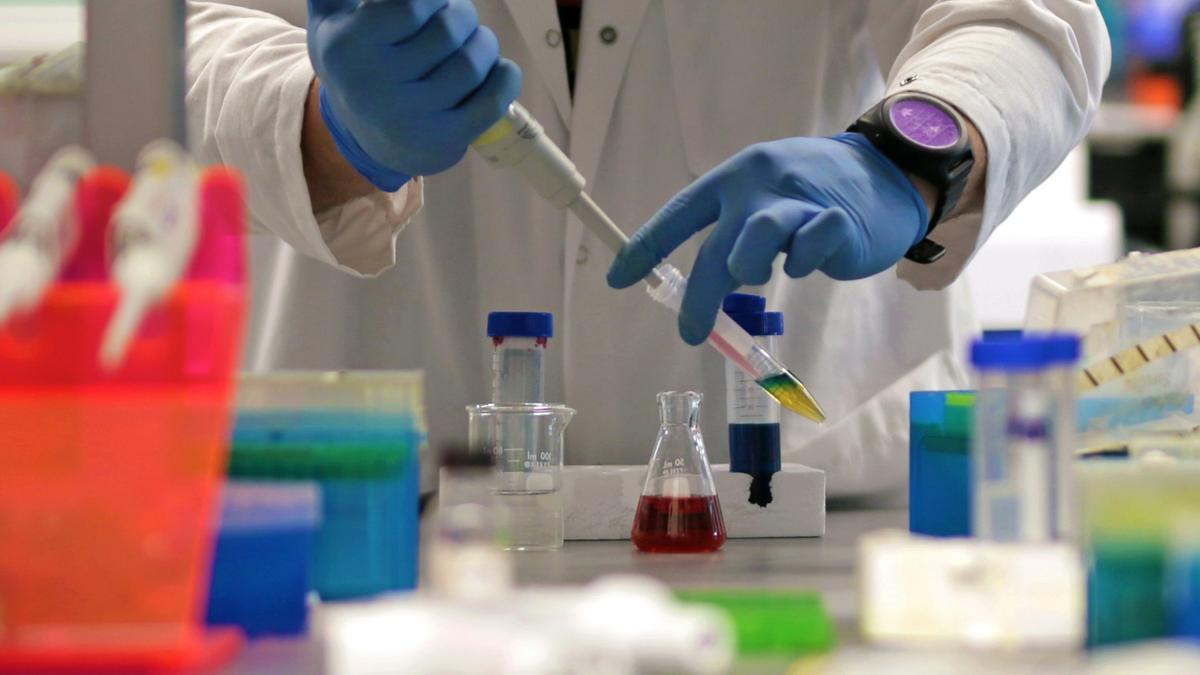
- 23 Sep 2025
In News:
- The Indian Council of Medical Research (ICMR) — India’s apex body for biomedical and health research — has introduced the Impact of Research and Innovation Scale (IRIS) to systematically measure the impact of biomedical, public health, and allied research projects.
- As India’s foremost grants-giving and policy-shaping institution in health research, ICMR’s adoption of IRIS is expected to significantly influence the country’s scientific and academic landscape.
Objective and Design
IRIS seeks to create a uniform and quantifiable metric to evaluate research outcomes. It introduces the concept of “publication-equivalents” (PEs) as the unit of measurement.
- A peer-reviewed research paper or systematic review carries 1 PE.
- A paper cited in policies or guidelines earns 10 PEs.
- A patent is valued at 5 PEs, while a commercially used device attracts 20 PEs.
By linking these metrics to funding and recognition, IRIS aims to encourage outcome-oriented research, policy translation, and innovation across disciplines such as biochemistry, clinical medicine, public health, and biomedical engineering.
Potential Benefits
- Standardisation of Evaluation:IRIS offers a common yardstick across scientific domains, enabling fairer comparisons of research productivity and impact.
- Recognition Beyond Citations:Unlike traditional citation-based indices, IRIS recognises diverse contributions such as patents, policy impact, and product development — providing a broader view of research value.
- Policy and Funding Integration:The framework can help align funding priorities with national health goals by linking measurable impact to resource allocation, thus encouraging translation of research into public health outcomes.
- Encouragement for Innovation:The model rewards applied research, particularly innovations that reach commercialization or large-scale public use, which may accelerate India’s biomedical innovation ecosystem.
Concerns and Limitations
Despite its intent, the framework faces methodological and ethical challenges.
- Conceptual Weakness: The PE values appear arbitrary and lack robust theoretical justification. Influential works — such as commentaries or perspective papers — receive zero PEs, despite their historical significance in shaping medical thought.
- Skewed Incentives: By assigning higher PEs to commercial devices (20) than to policy-level impact (10), IRIS risks overemphasizing commercialization at the cost of basic science and public health research. Transformative community-based interventions like India’s Home-Based Neonatal Care or nutrition trials in tuberculosis (RATIONS) may be undervalued.
- Ethical Concerns: The model could encourage metric manipulation or narrow research choices, especially in an ecosystem where research integrity is still evolving.
- Erosion of Science as a Public Good: Over-commercialization may undermine the ethos of research serving societal well-being rather than profit motives.
Way Forward
For IRIS to gain legitimacy, transparency, inclusivity, and peer validation are essential. Experts suggest conducting a national-level Delphi study to achieve consensus among researchers on PE assignment. Moreover, independent data verification and periodic review of the framework can ensure its adaptability and credibility.
Conclusion
Measuring research impact is inherently complex, and no single metric can capture the multifaceted nature of scientific contribution. While IRIS holds promise in standardizing research evaluation and fostering innovation, it must balance quantitative assessment with qualitative judgment, ensuring that India’s public health priorities and the spirit of science as a public good remain at its core. The success of IRIS will depend not merely on what it measures, but on whether it nurtures a research culture driven by ethics, relevance, and societal impact.
India’s Unique Genetic Legacy
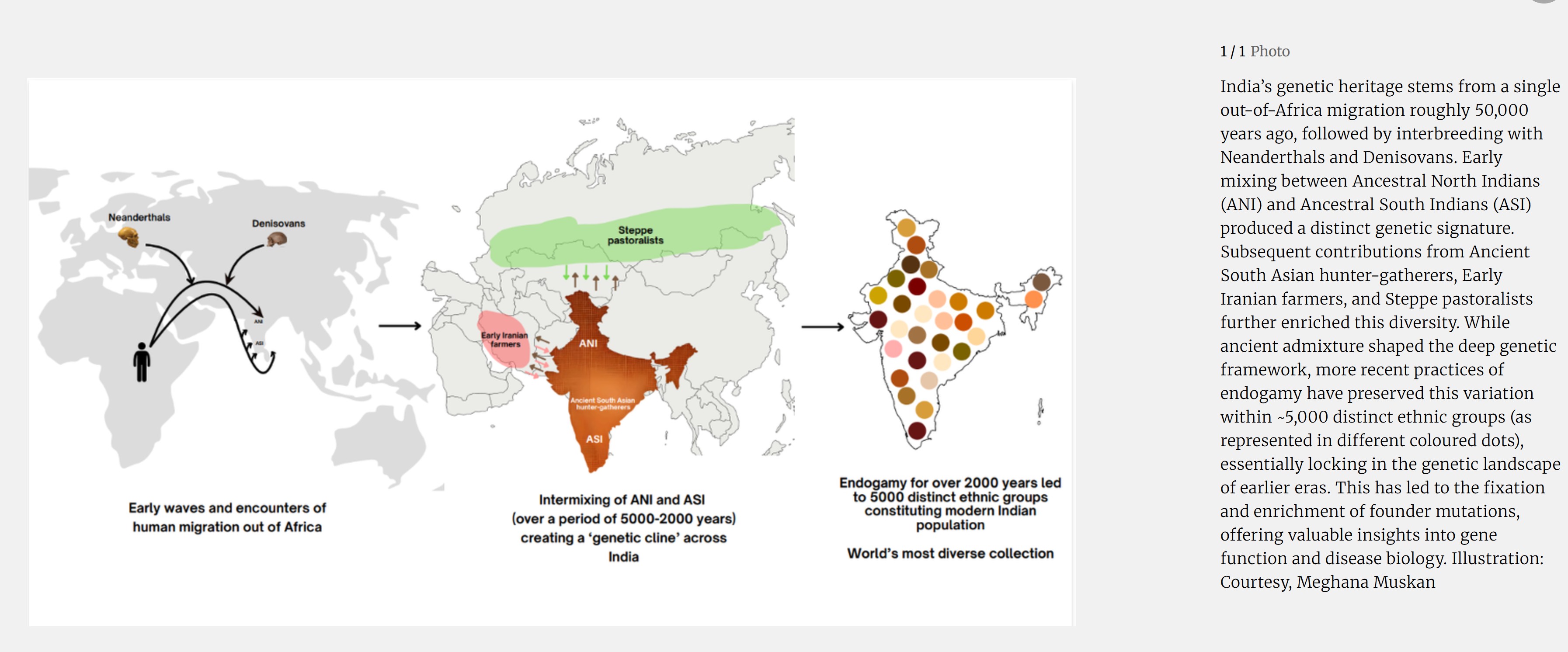
- 17 Aug 2025
Context:
India, with a population of over 1.4 billion and nearly 5,000 distinct ethnic groups, represents one of the richest reservoirs of human genetic diversity in the world. This diversity, shaped by ancient migrations, interbreeding with archaic humans, and centuries of endogamy, makes India a living archive of evolutionary history as well as a frontier for personalised medicine.
Evolutionary Roots and Genetic Mixing
The genetic history of Indians can be traced to a single out-of-Africa migration around 50,000 years ago. These early settlers interbred with archaic humans such as Neanderthals and Denisovans, leaving modern populations with 1–2% of archaic DNA. Some of these variants continue to influence present-day biology—for example, Denisovan genes aiding Tibetan high-altitude adaptation and Neanderthal genes linked to immune responses and even COVID-19 severity.
Within India, genetic blending between Ancestral North Indians (ANI) and Ancestral South Indians (ASI) created a distinct genetic signature. Later contributions from ancient hunter-gatherers, early Iranian farmers, and Steppe pastoralists added further complexity. This intricate demographic history is preserved in the unique genomic architecture of Indian populations, which remains poorly represented in global studies such as the UK Biobank or 1000 Genomes Project.
Endogamy and Disease Patterns
A distinctive feature of Indian society has been endogamy, or marrying within one’s community. While this preserved ancient traits, it also intensified genetic relatedness and strengthened “founder effects.” As a result, many rare recessive diseases occur at unusually high frequencies within specific groups.
For instance, the Vysya community shows a hundred-fold higher prevalence of butyrylcholinesterase deficiency, while other groups carry unique mutations linked to progressive pseudorheumatoid dysplasia or congenital disorders. Large-scale genome sequencing of ~2,700 Indians revealed that each person, on average, has at least one fourth-degree relative, underscoring the depth of relatedness. More than 1.6 lakh previously unreported variants have been identified, many linked to neurological, metabolic, and cardiovascular conditions.
Scientific and Healthcare Potential
This diversity is not merely of anthropological interest but holds transformative implications for medicine. Each Indian community functions as a natural genetic laboratory, preserving rare variants that allow scientists to study gene functions without laboratory-induced mutations. This provides an unprecedented opportunity to advance precision medicine, drug discovery, and disease prevention strategies tailored to Indian populations.
The Genome India Project, which has already sequenced 10,000 genomes, is a milestone towards this goal. Scaling it to millions of individuals, coupled with the creation of a national biobank on the lines of the UK Biobank, could position India as a global hub for genome-driven healthcare and innovation.
Challenges and Way Forward
Despite these opportunities, India faces major gaps. Representation in international genomic databases remains minimal. The risks of genetic discrimination and privacy breaches call for a robust ethical and legal framework. Moreover, integrating genetic screening into public health policy requires awareness campaigns, trained professionals, and equitable access to avoid deepening existing inequalities.
Conclusion
India’s genetic mosaic is both a scientific treasure and a public health imperative. By scaling up sequencing, building inclusive biobanks, and embedding genomics into healthcare policy, India can simultaneously improve disease management, reduce the burden of rare disorders, and emerge as a leader in global genomics research. With foresight, investment, and ethical safeguards, India’s genetic legacy can be harnessed to transform healthcare and strengthen its knowledge economy.
NISAR Mission: A Landmark in Indo-US Space Cooperation and Earth Observation
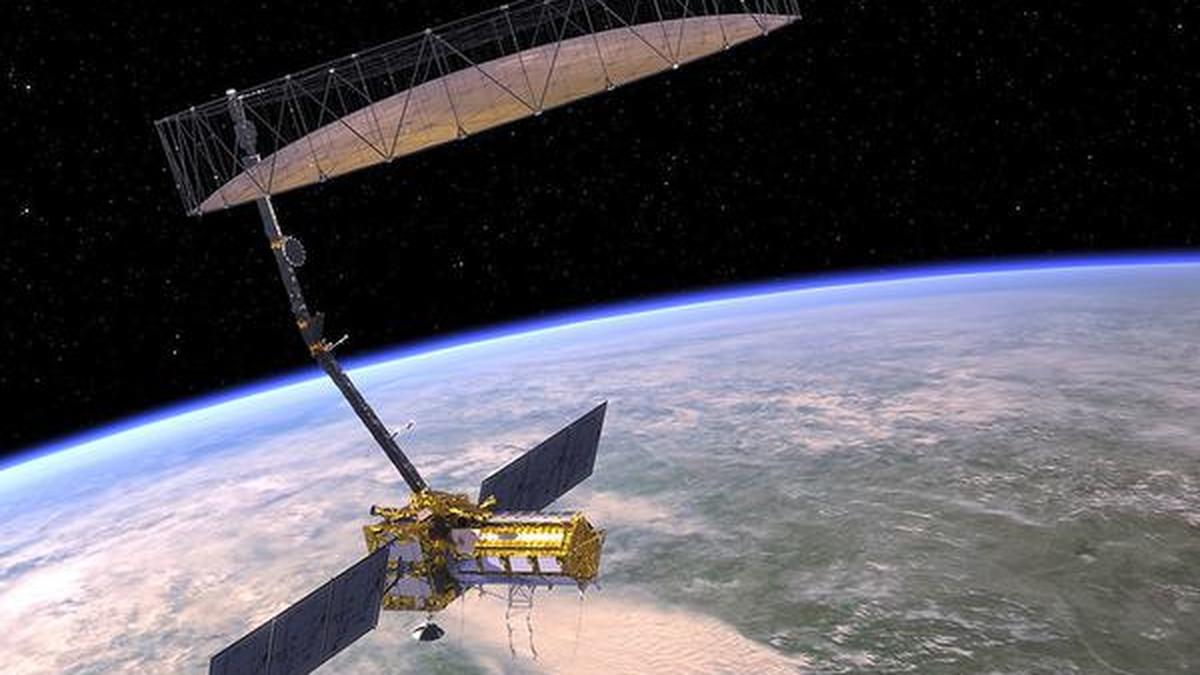
- 29 Jul 2025
In News:
The upcoming launch of the NASA-ISRO Synthetic Aperture Radar (NISAR) satellite represents a landmark in Indo-U.S. collaboration in space science. Scheduled for deployment from Sriharikota onboard a GSLV Mk-II rocket, NISAR is poised to become one of the most sophisticated Earth observation missions globally, with wide-ranging scientific, environmental, and developmental implications.
Background and Mission Overview
NISAR, developed jointly by NASA and ISRO over the past decade at a cost of approximately ?12,000 crore, is designed to provide high-resolution, all-weather, day-and-night radar imaging of the Earth’s surface. It is the first satellite globally to incorporate dual-frequency synthetic aperture radar (SAR)—combining NASA’s L-band radar (1.257 GHz) and ISRO’s S-band radar (3.2 GHz).
This dual-frequency capability enables it to penetrate forest canopies and surface layers, allowing comprehensive monitoring of dynamic Earth processes such as land deformation, biomass change, glacier dynamics, and infrastructure stability.
Technical Capabilities and Orbit
The satellite will operate from a sun-synchronous polar orbit at an altitude of 747 km. It features a 12-metre deployable mesh antenna and uses SweepSAR technology for electronically steering radar beams. With a 240 km swath width and spatial resolution between 3–10 meters, it can revisit every point on Earth every 12 days, facilitating consistent long-term monitoring.
Applications Across Critical Sectors
NISAR’s data will address six broad thematic areas:
- Solid Earth Processes: Detecting earthquakes, landslides, and urban subsidence.
- Ecosystem Dynamics: Estimating forest biomass, carbon stocks, and biodiversity changes.
- Cryosphere Studies: Tracking glacier movements and polar ice thickness.
- Coastal Monitoring: Observing shoreline erosion and marine hazards.
- Disaster Management: Generating damage proxy maps within five hours of events like floods or cyclones.
- Agriculture and Infrastructure: Supporting food security, yield estimation, and infrastructure health monitoring.
India-specific applications include real-time soil moisture analysis, crop forecasting, flood mapping, and disaster relief planning. The S-band will be operated more intensively over Indian territory, addressing national developmental priorities.
Collaborative Contributions
The mission reflects a balanced international partnership. ISRO has provided the spacecraft bus, S-band radar, telemetry systems, and launch services, while NASA has contributed the L-band radar, antenna system, onboard electronics, and global data infrastructure. Final integration and testing were conducted in Bengaluru, reinforcing India's growing capability in complex space missions.
Data Policy and Accessibility
Following an open data policy, NISAR will make its data freely accessible to scientists, governments, and the public. ISRO’s Shadnagar ground station and Antarctica node will handle domestic reception and processing, while NASA will manage global downlink via its Near Earth Network.
Significance for India and the World
NISAR enhances India’s Earth observation portfolio and strengthens climate resilience, agricultural sustainability, and disaster preparedness. It also elevates India’s profile in global space diplomacy, aligning with goals under climate action, SDGs, and science diplomacy.
In conclusion, NISAR is not just a technological achievement but a strategic asset for planetary monitoring and sustainable development, embodying the spirit of science for global good and showcasing India’s capacity to lead in international space cooperation.
Matter-Antimatter Asymmetry
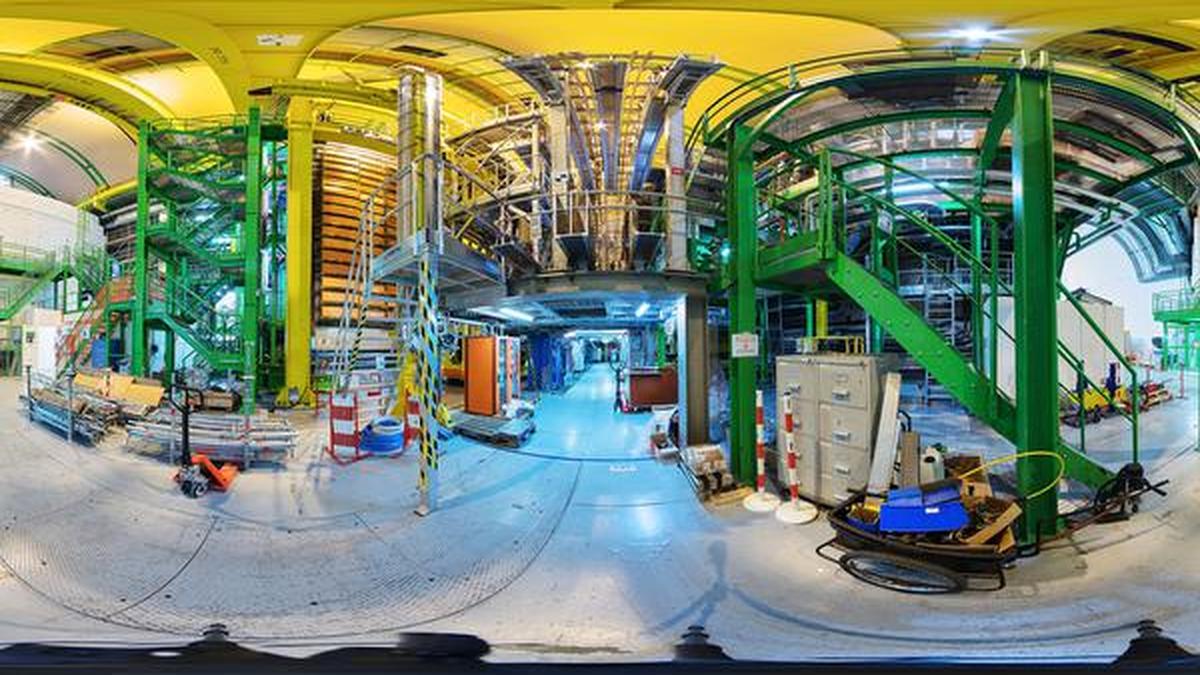
- 24 Jul 2025
Context:
One of the most fundamental questions in cosmology and particle physics is: Why does the universe contain more matter than antimatter? The Big Bang, which occurred around 13.8 billion years ago, should have produced equal amounts of matter and antimatter. However, the observable universe today is overwhelmingly composed of matter, with antimatter being nearly absent except in trace amounts created in high-energy environments or particle accelerators. This puzzling imbalance—known as baryon asymmetry—continues to challenge scientists worldwide.
Recent breakthroughs, particularly a discovery made on July 16 at the Large Hadron Collider (LHC) in Europe, have added a significant piece to this puzzle. For the first time, scientists observed CP violation in baryons—heavy subatomic particles such as protons and neutrons made of three quarks. CP stands for Charge Conjugation (C) and Parity (P), which together form a symmetry principle stating that the laws of physics should be the same if a particle is replaced with its antiparticle and viewed in a mirror. A violation of this symmetry implies that matter and antimatter behave slightly differently—a necessary condition for the observed dominance of matter.
The experiment focused on a baryon called Λb0 (lambda-b-zero), which contains one up quark, one down quark, and one bottom quark. Scientists at LHCb measured the decay rates of Λb0 and its antimatter counterpart (Λb0-bar) into a proton, kaon, and two pions. The results showed a CP asymmetry of about 2.45%, with a statistical significance of over 5 sigma, a threshold used in particle physics to confirm a discovery. This historic observation is the first evidence of CP violation in baryons and expands our understanding beyond earlier CP violation detected in mesons (quark-antiquark pairs).
While this asymmetry is still insufficient to fully explain the matter-antimatter imbalance, it marks a critical advancement. It suggests that there could be undiscovered sources of CP violation in other particles or interactions that the Standard Model of particle physics does not yet account for. Theoretical and experimental physicists are now exploring whether other decays exhibit similar asymmetries and whether new physics—beyond the Standard Model—might be at play.
Parallel efforts are also underway deep underground. In Italy, physicists are assembling detectors 1.4 km below the mountains to observe neutrinoless double beta decay, a hypothetical nuclear process that, if confirmed, would indicate that neutrinos are Majorana particles—particles that are their own antiparticles. This would offer a different mechanism for matter creation without equivalent antimatter, further contributing to the asymmetry.
Moreover, U.S. institutions such as the Department of Energy (DOE) support advanced antimatter research through projects like the Deep Underground Neutrino Experiment (DUNE) and experiments at Brookhaven’s Relativistic Heavy Ion Collider, which have created antimatter versions of elements such as helium.
In conclusion, the recent detection of CP violation in baryons and continued investigations into rare decays and neutrino properties are gradually illuminating the deep cosmic mystery of why something exists instead of nothing. This line of inquiry not only bridges particle physics and cosmology but also exemplifies human curiosity’s power in probing the origins of existence itself.
India’s Quantum Leap in Secure Communication

- 26 Jun 2025
In News:
Recently, India marked a major milestone in quantum technology with the successful demonstration of quantum secure communication over free space by IIT Delhi, in collaboration with the Defence Research and Development Organisation (DRDO). This achievement represents a significant step forward in India’s pursuit of quantum cybersecurity, quantum networks, and the future quantum internet, with vital applications in both defence and civilian domains.
What is Quantum Communication?
Quantum communication leverages principles of quantum mechanics, particularly quantum entanglement, to enable secure data transmission. In entanglement, the quantum state of two or more particles (usually photons) becomes correlated such that the measurement of one instantly determines the state of the other—regardless of the distance between them.
Security Advantage: Any attempt to intercept or measure the entangled photons disturbs their state, instantly revealing the breach. This makes quantum communication unbreakable by classical computational means.
Quantum Key Distribution (QKD): The Core Mechanism
Quantum communication is often employed for Quantum Key Distribution (QKD)—a method to securely generate and share encryption keys between two parties. Once both parties obtain identical secret keys via QKD, traditional algorithms (like AES) can be used to encrypt and decrypt actual messages.
There are two main types of QKD:
- Prepare-and-Measure QKD: Single photons are prepared in specific states and then measured.
- Entanglement-Based QKD: Pairs of entangled photons are distributed between users; any interception disturbs the entanglement, flagging the intrusion.
IIT-Delhi’s 2025 Breakthrough: Key Highlights
- Achievement: Demonstrated entanglement-assisted free-space QKD over a distance of more than 1 km at IIT Delhi campus.
- Secure Key Rate: ~240 bits per second.
- Quantum Bit Error Rate (QBER): <7%, which is acceptable under current protocols.
- Setting: Conducted under the DRDO-funded project “Design and development of photonic technologies for free space QKD”, in the presence of senior dignitaries from DRDO and IIT Delhi.
Free-space QKD offers a critical advantage—eliminating the need for laying optical fibres, making it viable in mountainous terrain and congested urban zones.
Previous Achievements by the IIT-Delhi & DRDO Team
- 2022: India’s first intercity quantum communication link established between Vindhyachal and Prayagraj using commercial dark optical fibre.
- 2023: Achieved QKD over 380 km using optical fibre with a QBER of 1.48%.
- 2024: Demonstrated entanglement-based QKD over 100 km using telecom-grade optical fibre.
Significance:
Strategic Applications:
- Defence Communication: Enables tamper-proof messaging and data sharing during operations.
- Cybersecurity: Shields critical infrastructure from quantum and AI-based cyber threats.
- Surveillance Immunity: Makes quantum networks resilient to conventional hacking or surveillance.
Civilian Applications:
- Banking and Finance: Secure real-time financial data transmission.
- Telecommunications: Enhances privacy in communication systems.
- Quantum Internet: Enables ultra-secure networking, distributed quantum computing, and time-synchronised communication.
Quantum Networks and the Road Ahead
India’s long-term goal is to establish a multi-node quantum network capable of secure long-range communication. This includes establishing:
- Satellite-to-ground QKD links, enabling nation-wide secure key distribution.
- Urban quantum networks, ensuring secure communication for government and military hubs.
India is drawing inspiration from China’s 4,600 km quantum network and U.S. plans for a quantum internet by the 2030s.
To this end, the National Quantum Mission (NQM) was approved in 2023, with an outlay of ?6,000 crore (2023–2031). It aims to:
- Develop 20–50 qubit quantum computers.
- Build quantum communication and sensing technologies.
- Establish four Thematic Hubs on quantum applications in computing, metrology, communication, and materials.
Institutional Mechanism: DIA-CoEs
The work was conducted under the DRDO-Industry-Academia Centre of Excellence (DIA-CoE) model. DIA-CoEs are collaborative platforms set up in premier academic institutions such as IITs and IISc, focused on developing cutting-edge defence technologies.
There are 15 DIA-CoEs currently operational across India.
Conclusion: India’s Quantum Communication Trajectory
India’s demonstration of free-space quantum secure communication marks a critical leap in strategic technology self-reliance. With continued support through the National Quantum Mission and institutional synergy between academia, industry, and the military, India is well-positioned to emerge as a global leader in quantum-enabled security infrastructure.
Technology Industry and Climate Goals
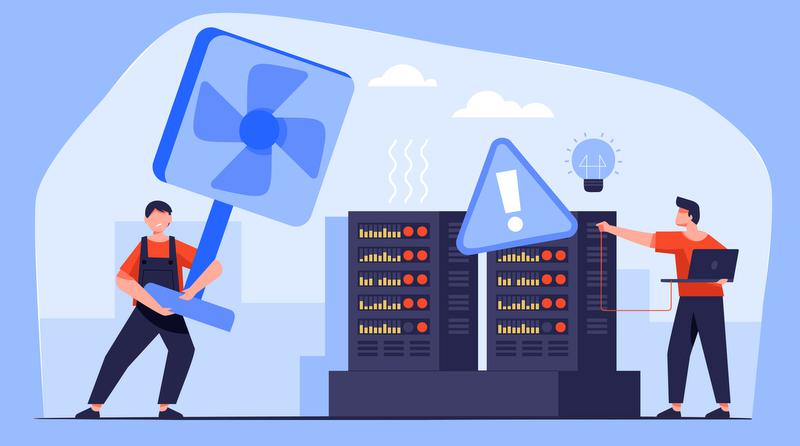
- 03 Jun 2025
Introduction
The global technology sector, while being a driver of economic growth and innovation, is also a significant contributor to greenhouse gas (GHG) emissions. With the rapid expansion of cloud computing and digital services, data centres—the backbone of the digital economy—consume massive amounts of energy, primarily for cooling.
A recent landmark study by Microsoft and WSP Global, published in Nature, highlights the potential of advanced cooling technologies to significantly reduce the environmental footprint of data centres.
The Problem: Heat and Emissions from Data Centres
- Energy Consumption: In modern data centres, cooling systems consume nearly as much electricity as computing itself.
- Heat Management: As chips become smaller and faster, they generate more heat. Without effective cooling, systems overheat, leading to failure and reduced efficiency.
- Climate Targets: The Information and Communications Technology (ICT) sector aims to reduce emissions by 42% by 2030 (from 2015 levels) and achieve net-zero by mid-century.
Cooling Innovations: The Game-Changers
1. Cold Plate Cooling (Direct-to-Chip Cooling)
- Coolant flows through microchannels on a plate attached directly to the chip.
- Reduces the need for energy-intensive air conditioning.
- Heat is transferred away efficiently and silently.
2. Immersion Cooling
- Entire hardware systems are submerged in thermally conductive, non-conductive liquid.
- Uses one-phase (liquid remains stable) or two-phase (liquid vaporises and condenses) systems.
- Ensures near-total heat dissipation and longer component life.
Environmental Impact (Study Findings):
Compared to traditional air cooling:
- GHG Emissions ↓ by 15–21%
- Energy Use ↓ by 15–20%
- Water Consumption ↓ by 31–52%
With 100% renewable energy:
- Emissions ↓ by 85–90%
- Water use ↓ by 55–85%
Tech Industry’s Broader Climate Actions
- Carbon Credits: Google, Netflix, and others invest in verified carbon offsets.
- Blockchain for Carbon Markets: Ensures transparency; used by Indian IT firms for ESG compliance.
- Renewable Energy: Tech giants like Apple, Meta, and Amazon power operations with green energy.
- Indian Leadership: Infosys, Reliance, and Tech Mahindra lead in green operations using AI and energy-efficient systems.
Challenges and Limitations
- Lifecycle Trade-offs: Coolant production and disposal can offset benefits.
- Capital Cost: Retrofitting old data centres is expensive.
- Regulatory Issues: Lack of global standards for coolants and fragmented carbon credit policies.
- Dependence on Grid: Benefits are reduced if electricity is still coal-based.
- Slow Deployment: Complex designs and supply chain delays hinder implementation.
Way Forward
- Life Cycle Assessments (LCAs): Evaluate true environmental costs over the product lifecycle.
- Unified Carbon Standards: Develop global frameworks for carbon credit verification and climate disclosures.
- Government Support: Provide tax incentives, green finance, and subsidies for early adopters.
- Strengthen R&D: Focus on low-impact coolants and AI-driven cooling systems.
- Public-Private Partnerships: Encourage innovation through collaboration among tech firms, startups, and governments.
Conclusion
The technology industry stands at a crossroads where sustainable innovation is essential. Cooling technologies like cold plates and immersion cooling, coupled with renewable energy adoption and carbon offset mechanisms, can enable the ICT sector to significantly reduce its environmental footprint. With effective policy support and strategic innovation, the tech sector can become a pillar of global climate action.
Base Editing Breakthrough
- 29 May 2025
In News:
In a landmark medical feat, a nine-month-old American boy, Kyle “KJ” Muldoon Jr., became the first known human to be successfully treated using base editing, a next-generation gene editing technique derived from CRISPR-Cas9. KJ was born with Carbamoyl Phosphate Synthetase I (CPS1) deficiency, a rare genetic disorder that disrupts nitrogen breakdown, leading to toxic ammonia buildup—known as hyperammonemia—which can be fatal if untreated.
From CRISPR-Cas9 to Base Editing: Evolution of Gene Editing Tools
CRISPR-Cas9, developed in 2012 by Jennifer Doudna and Emmanuelle Charpentier, revolutionized biotechnology and earned them the 2020 Nobel Prize in Chemistry. Modeled after a microbial immune system, CRISPR works by creating “genetic memory”—capturing viral DNA and guiding the Cas9 enzyme, which acts as molecular scissors, to target and cut specific DNA sequences. This enables scientists to eliminate or repair faulty genes by inducing a double-strand break followed by insertion of a corrected DNA sequence.
However, the double-strand break mechanism raised concerns about unintended genetic consequences. Enter base editing, a refined tool that modifies single DNA bases—the letters A, T, C, G—without cutting both strands of the DNA. Instead of scissors and glue, base editing works like a pencil and eraser, replacing one incorrect base pair with the correct one using a fusion of Cas9 and a base-modifying enzyme. In KJ’s case, the specific base mispair causing CPS1 deficiency was successfully corrected using this technique.
Advantages of Base Editing
- Precision and Safety: Avoids double-strand breaks, reducing off-target effects.
- Compactness: Easier to deliver to cells via viral vectors.
- No foreign DNA: Eliminates need for donor DNA insertion.
- Customisation: Suitable for diseases caused by single-nucleotide mutations.
Challenges: Economic, Ethical, and Regulatory
Despite its promise, base editing faces several bottlenecks:
- Cost and Accessibility: The procedure is prohibitively expensive—estimated in the range of hundreds of thousands of dollars—and was funded by research institutions and biotech firms in KJ’s case.
- Scalability: The therapy was custom-designed for KJ’s specific mutation, limiting its use for others. Such personalised medicine lacks the economies of scale that attract pharmaceutical investment.
- Regulatory hurdles: Countries like India face issues of bureaucratic red tape and outdated ethical frameworks that delay the deployment of advanced genomic therapies.
- Ethical concerns: As the technology becomes more powerful, there are concerns about misuse, eugenics, and the potential editing of germline cells.
Conclusion
KJ’s treatment marks a paradigm shift in personalised medicine, highlighting the transformative potential of base editing in addressing rare and otherwise untreatable genetic disorders. However, wider application requires systemic reforms in bioethics, regulatory frameworks, and healthcare infrastructure. To ensure equitable access, future efforts must focus on cost reduction, public funding, global collaboration, and ethical oversight. If successfully scaled, base editing could revolutionise medicine for millions suffering from rare genetic diseases.
State Space Policies of Gujarat and Tamil Nadu
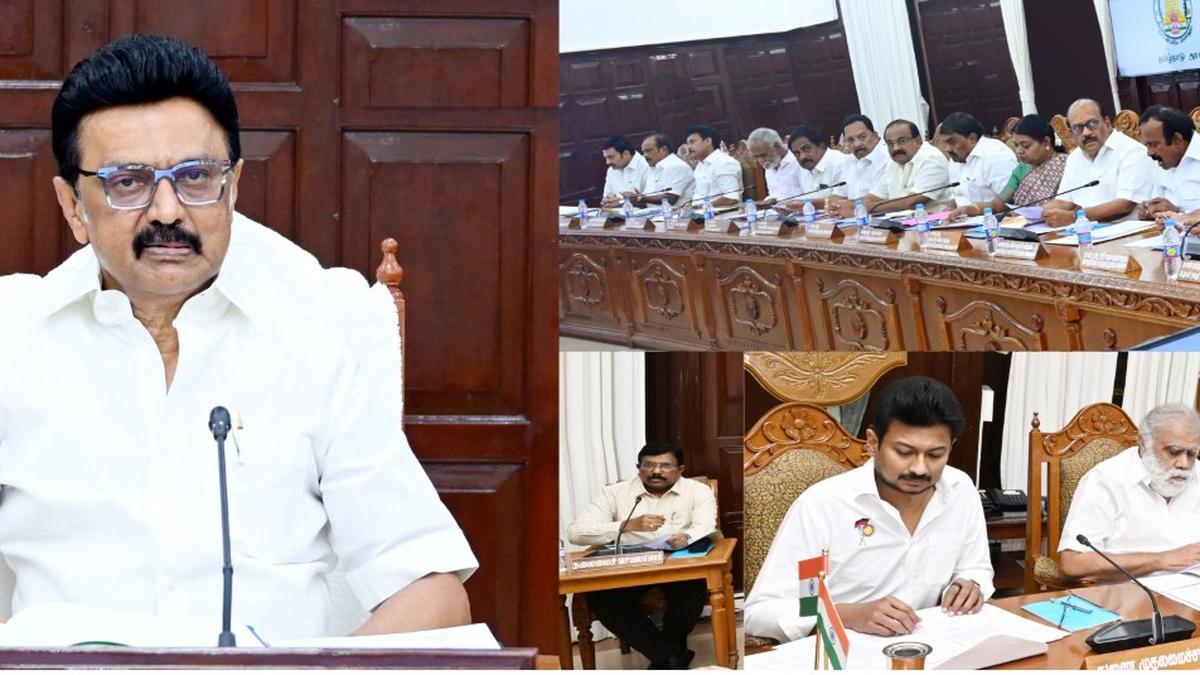
- 27 May 2025
In News:
India’s space sector, traditionally dominated by public institutions like ISRO, has seen major policy shifts since 2020 to enable private participation. In a significant development, Gujarat and Tamil Nadu have become the first Indian states to formulate state-level space policies, aiming to bolster private investment, foster innovation, and generate employment.
Recently, Gujarat launched the Space Tech Policy 2025–30, becoming the first state to do so. A day later, Tamil Nadu approved its Space Industrial Policy 2025. These policies complement the Indian Space Policy 2023 and the liberalisation of FDI norms in the space sector. They also align with national efforts led by IN-SPACe (Indian National Space Promotion and Authorization Centre), established in 2022 to facilitate private sector engagement in space activities.
Key Features and Objectives
Employment and Investment Targets:
- Gujarat aims to create 25,000 jobs, while Tamil Nadu targets 10,000 new high-skilled jobs.
- Tamil Nadu expects to attract ?10,000 crore in investments over five years.
Sectoral Scope: Both policies aim to develop a full spectrum of space-tech activities including:
- Satellite payload and component manufacturing
- Communication and propulsion systems
- Ground stations and control centres
- Space application software and analytics
State-specific Incentives:
- Gujarat will provide launch and patent support, capital incentives via the Gujarat Electronics Policy, and access to benefits under the IT/ITeS and Deep Tech Start-up Programme.
- Tamil Nadu offers capital subsidies up to 20%, a ?10 crore Space Tech Fund, payroll subsidies up to 30% in the first year, and location-based investment incentives.
Infrastructure and Ecosystem Development
- Gujarat plans to establish a Centre of Excellence in Space Technology and a dedicated manufacturing cluster in Sanand, near Ahmedabad.
- Tamil Nadu will create TNSpaceBays, special industrial zones catering to MSMEs, deep-tech start-ups, R&D labs, and international players.
- New satellite testing infrastructure and skill development programmes are planned in Chennai.
Strategic Importance
The policies reflect recognition of space technology’s growing importance in national security, navigation, healthcare, internet services, weather forecasting, and disaster management. Missions such as Chandrayaan, Mangalyaan, and SpaDeX have enhanced India’s global space credentials, motivating states to leverage their talent and industrial ecosystems to participate in this high-value sector.
These state initiatives also resonate with India’s broader push towards Atmanirbhar Bharat, by promoting domestic manufacturing and reducing dependence on imports in critical technology sectors.
Conclusion
The Gujarat and Tamil Nadu space policies mark a paradigm shift in India’s sub-national innovation strategy. By aligning with central space policy reforms and incentivising private participation, these states are poised to become key hubs in India’s space-tech value chain. Such proactive state-level interventions are vital for India’s ambition to emerge as a global space power and offer a replicable model for other states like Karnataka and Telangana, which are also planning similar initiatives.
Nutrition and Education: UNESCO’s Call for Integrated Human Capital Development

- 02 Apr 2025
Context:
In March 2025, UNESCO released its global report titled “Education and Nutrition: Learn to Eat Well” at the ‘Nutrition for Growth’ summit in France. The report brings to light the critical intersection between child nutrition and educational outcomes, positioning school feeding programs not merely as welfare schemes but as foundational investments in human capital.
Global and Indian Context
As per the report, 418 million children across 161 countries benefit from school meal programs, yet over half of these initiatives lack adequate portions of fruits and vegetables. Alarmingly, nearly one-third of the programs include sugary beverages. This dietary imbalance is reflected in the rising tide of childhood obesity, which has doubled in over 100 countries in the past two decades.
In India, the PM-POSHAN (formerly Mid-Day Meal) scheme remains a vital intervention, feeding approximately 118 million children daily, making it one of the largest school meal programs globally. Despite this extensive reach, the report notes a persisting issue of "hidden hunger" — widespread micronutrient deficiencies stemming from poor dietary diversity.
Nutrition-Education Nexus
The report strongly advocates for recognizing nutrition as an enabler of learning. Well-balanced meals in schools contribute to better attention spans, memory retention, and academic performance. In countries like Brazil and Finland, where nutrition programs are closely aligned with educational frameworks, data shows improved enrolment, retention, and performance metrics.
School meals also serve as instruments of social equity, especially for children from low-income families and marginalized communities. They act as a safety net, improving attendance — particularly for girls — and reducing hunger-related learning barriers. When sourced locally, these programs can additionally boost rural economies and support sustainable agriculture, creating farm-to-table ecosystems.
Challenges Identified
The report flags several systemic challenges. A majority of school feeding programs are heavily dependent on staple grains, offering minimal variety. Many meals still include ultra-processed and low-nutrient foods, while nutrition education remains largely absent from school curricula — only 17 countries integrate it with national food standards.
Further, an urban-rural divide in infrastructure, such as cold storage and supply chains, leads to inconsistent delivery. Monitoring gaps also persist — just 8% of countries track school meals against WHO nutritional standards, making outcome assessment difficult.
Recommendations and Way Forward
UNESCO proposes a holistic approach for countries to bridge the education-nutrition divide:
- Curriculum Integration: Nutrition should be embedded into educational content across disciplines and levels.
- Science-Based Standards: National guidelines should align with WHO dietary recommendations.
- Local Procurement: Meal sourcing must prioritize seasonal and region-specific produce to enhance diversity.
- Teacher Training: Educators should be equipped to impart food literacy effectively.
- Robust Monitoring: Countries must develop national strategies on school nutrition with clear benchmarks, accountability, and evaluation mechanisms.
Conclusion
The report makes a compelling case that education and nutrition must be interlinked to foster meaningful development. Investing in nutritious school meals is not merely about feeding children — it is about shaping a healthier, more capable future generation. In the long run, a well-nourished child is better positioned to learn, thrive, and contribute to nation-building, making this a strategic priority for policymakers worldwide.
India’s Deep Tech Ecosystem & the Government’s ?20,000 Crore Funding Initiative
- 27 Mar 2025
Context:
India’s deep technology (deep tech) sector is emerging as a key driver of transformative innovation, leveraging advanced scientific breakthroughs to address complex challenges across sectors such as defence, healthcare, artificial intelligence (AI), biotechnology, aerospace, and renewable energy. Deep tech encompasses disruptive technologies including AI and machine learning, quantum computing, biotechnology, advanced materials, robotics, and aerospace systems.
Growth and Potential of India’s Deep Tech Sector
India’s deep tech ecosystem has seen rapid expansion in recent years. According to NASSCOM’s 2024 report, over 3,600 deep tech startups operate in India, with 480 new startups launched in 2023 alone, doubling the number from the previous year. While India ranks as the third-largest startup ecosystem globally, its deep tech sector ranks sixth worldwide. This growth reflects a rising blend of entrepreneurial ambition, government support, and increasing collaboration between academic institutions, research organisations, and industry.
Government initiatives such as the Draft National DeepTech Start-up Policy, the National Quantum Mission, India AI Mission, and substantial venture capital funds (e.g., ?1,000 crore for space tech startups) underscore India’s commitment to strengthening this ecosystem. Programmes like the Atal Innovation Mission, NITI Aayog’s innovation initiatives, and Start-up India provide critical support through incubators, accelerators, and funding mechanisms.
The ?20,000 Crore Deep Tech Fund
In the Union Budget 2024-25, Finance Minister announced a ?20,000 crore allocation as a 50-year interest-free loan to private sector-driven deep tech research and innovation. The fund aims to catalyse cutting-edge R&D and position India as a global leader in disruptive technologies.
However, the Parliamentary Standing Committee on Science and Technology, Environment, Forests and Climate Change has raised significant concerns about this scheme. While acknowledging the boldness of the initiative, the Committee warned of risks including potential misallocation of funds, national security implications, and low return on investment for the government. It expressed doubts over the competence of fund managers in selecting impactful projects, cautioning that private entities might benefit disproportionately at public expense.
The Committee suggested that directing such substantial funding toward government research institutions might yield more measurable impact. It emphasized the need for transparency, accountability, and a robust framework to guide the implementation of the fund.
Underutilisation of Scientific Research Funds and Reviving Public Sector Units
The Committee also flagged suboptimal utilisation of allocated funds by the Department of Scientific and Industrial Research, with over half of the budget remaining unused late into the financial year. A significant portion (62%) is consumed by salaries and pensions, leaving limited funds for actual research and infrastructure development.
Further, the Committee highlighted concerns over the poor condition of two public sector undertakings under the Department of Biotechnology—BIBCOL and IVCOL. It recommended their revival to ensure affordable vaccine availability domestically and improve India’s position in the global vaccine market, especially for exports.
Policy Recommendations and Future Outlook
To unlock the full potential of deep tech innovation, the Committee and experts suggest multiple policy measures for Budget 2025 and beyond:
- Ensuring long-term, patient capital through government grants and venture capital funds to meet the high risk and capital-intensive nature of deep tech ventures.
- Strengthening intellectual property rights and establishing commercialisation hubs for startups.
- Enhancing public-private partnerships and specialised talent development through tailored skilling and certifications in AI, robotics, and quantum computing.
- Modernising infrastructure by establishing research hubs, technology parks, and national facilities such as wind tunnels.
- Streamlining regulatory frameworks for faster deployment of emerging technologies like autonomous vehicles and drones.
- Promoting sustainability by incentivising green and climate tech innovations.
Conclusion:
India’s deep tech sector is poised for a transformative leap, but its success hinges on addressing governance, funding utilisation, and ecosystem-building challenges. The government’s strategic interventions and sound policy frameworks will be crucial in translating India’s scientific prowess into global technological leadership.
Growth and Challenges of India’s Private Space Sector
- 03 Mar 2025
Introduction
India’s space sector has experienced remarkable growth, especially with the advent of the Space Sector Reforms of 2020. These reforms have opened the door for greater private sector participation, spurring innovation, investment, and commercial growth. The Indian Space Research Organisation (ISRO) remains at the forefront of technological advancements, while a burgeoning ecosystem of space tech startups is positioning India as a key player in the global space economy.
Private Participation in India’s Space Industry
- Emerging Startups: Over 200 space startups have emerged, leveraging ISRO’s infrastructure such as testing, launch, and ground station facilities.
- Regulatory and Financial Support: The Indian National Space Promotion and Authorization Center (IN-SPACe) was created to facilitate private participation in space activities. It also launched a ?1,000 crore Venture Capital Fund to accelerate innovation within the sector.
- Commercial Arm of ISRO: Antrix Corporation, ISRO’s commercial arm, plays a crucial role in facilitating satellite launches and technology transfers, thus enhancing private capabilities.
- Growth in Payloads: The PSLV Orbital Experimental Module (POEM) program has increased startup payloads significantly, from 6 in 2022 to 24 in 2024.
Private Investment and Startup Innovations
- Venture Capital Investment: Private funding, particularly from MountTech Growth Fund – Kavachh (MGF-Kavachh), has been instrumental in driving growth. Over ?2,500 crore have been invested in space startups over the past three years.
- Startup Innovations:
- GalaxEye integrated Synthetic Aperture Radar (SAR) with optical imagery, a world-first achievement in rapid data compression.
- Pixxel is developing Firefly, the world’s most advanced hyperspectral satellite constellation.
- InspeCity (IIT Bombay) is working on innovative in-orbit satellite repair and refueling technologies.
- Skyroot and Agnikul are pioneering cost-effective private launch vehicles for satellite deployment.
Space Sector Reforms of 2020
The Space Sector Reforms of 2020 have been transformative in enabling greater private sector involvement across the entire spectrum of space activities, from satellite design to launch vehicle manufacturing:
- Expansion of Private Roles: The reforms allow private companies to engage in activities such as satellite design, launch vehicle manufacturing, and ground station services.
- Establishment of IN-SPACe: IN-SPACe was created as a regulatory body to facilitate the engagement of private entities in space activities, empowering them to operate independently from ISRO.
- Technology Transfer: The reforms have encouraged ISRO to transfer technology to private players through NewSpace India Limited (NSIL), enabling commercialization of indigenous space technologies.
Challenges Facing India’s Space Industry
- Funding Gaps: While venture capital interest is rising, early-stage funding remains limited, making it difficult for startups to scale effectively.
- Talent Shortage: There is a shortage of specialized educational institutions focused on space technology. Currently, India only has one Indian Institute of Space Technology (IIST), underscoring the need for more educational institutions and industry-academia collaborations.
- Global Competition: India faces stiff competition from countries like the US, China, and Russia, which have advanced space programs and capabilities such as reusable spacecraft and space tourism.
- Dependence on Foreign Launch Vehicles: Despite progress in domestic launch capabilities, many startups still depend on foreign rockets like SpaceX’s Falcon-9 due to cost and scheduling constraints.
Strategic Way Forward
- Boosting R&D and Infrastructure:
- Expand the domestic manufacturing of satellite components through the Production Linked Incentive scheme for space-grade components.
- Establish more space-focused educational institutions and create a dedicated space industrial corridor to boost satellite and launch vehicle manufacturing.
- Global Collaboration:
- Strengthen bilateral agreements with leading space agencies (NASA, ESA, Roscosmos) to foster collaboration in research and development.
- Promote rideshare missions to reduce satellite launch costs, benefiting startups.
- Technology Transfer and Commercialization:
- Enhance ISRO’s technology transfer initiatives to allow startups to commercialize homegrown innovations, driving economic growth in space-related industries.
Conclusion
India’s private space sector is undergoing a transformative shift, with increasing private sector participation, supportive reforms, and growing venture capital investment. While challenges such as funding gaps, talent shortages, and global competition remain, strategic measures to enhance R&D, infrastructure, and global collaborations can position India as a leading player in the global space economy. This growth aligns with India’s broader goals of technological advancement and economic development, while also contributing to global space exploration and sustainability.
Environmental Impacts of Artificial Intelligence
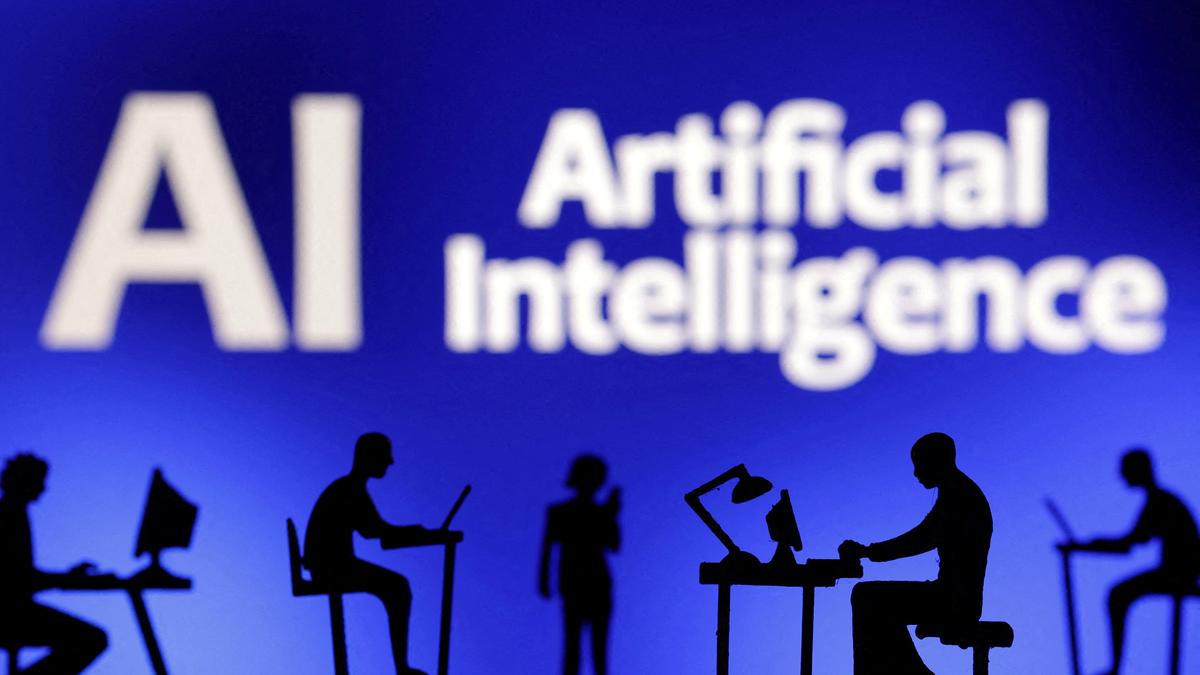
- 28 Feb 2025
Introduction
Artificial Intelligence (AI), encompassing technologies that simulate human thinking and decision-making, has become integral to contemporary life, influencing how we work, live, and conduct business. While AI’s foundational concepts date back to the 1950s, recent advances in computing power and data availability have fueled rapid growth. The global AI market, currently valued at $200 billion, is projected to contribute up to $15.7 trillion to the world economy by 2030. Major developments, such as the U.S.’s $500 billion Stargate Project and India's plans to build the world’s largest data centre in Jamnagar with Nvidia, highlight AI’s economic potential. However, this transformative technology also poses significant environmental challenges across its value chain.
Environmental Impact Across the AI Value Chain
The environmental footprint of AI emerges at multiple stages — from hardware production and model development to deployment and maintenance:
- Energy Consumption and Carbon Emissions:Data centres, the backbone of AI infrastructure, consume vast amounts of electricity, accounting for approximately 1% of global greenhouse gas emissions, a figure expected to double by 2026 (IEA). Advanced models like GPT-3 emit up to 552 tonnes of carbon dioxide equivalent during training, comparable to the annual emissions of dozens of cars. A single ChatGPT request consumes roughly ten times the energy of a standard Google search.
- E-Waste Generation and Resource Depletion:The rapid expansion of AI data centres exacerbates the e-waste crisis, with obsolete hardware often discarded irresponsibly. Manufacturing essential components like microchips demands rare earth minerals, mined through environmentally destructive processes.
- Water Usage:Data centres require millions of litres of water for cooling operations. Alarmingly, AI-related data centres are projected to consume six times more water than Denmark’s total usage, straining water resources, especially in regions already facing scarcity.
Global Awareness and Regulatory Efforts
Recognising the growing environmental burden, international organisations and governments have initiated efforts toward greener AI practices:
- At COP29, the International Telecommunication Union (ITU) underscored the urgent need for sustainable AI development.
- Regions like the European Union and the United States have introduced laws to mitigate AI’s environmental impact.
- However, despite over 190 countries adopting non-binding ethical AI guidelines, sustainability concerns remain largely absent from most national AI strategies.
Way Forward
To harmonise AI innovation with environmental responsibility, a multi-pronged approach is necessary:
- Clean Energy Adoption:Shifting to renewable energy sources for powering data centres and purchasing carbon credits are critical steps. Locating centres in regions rich in renewables can further lower carbon footprints.
- Efficiency in Hardware and Algorithms:Developing energy-efficient hardware and maintaining it regularly can substantially reduce emissions. Smaller, domain-specific models should be promoted to lessen computational demands.
- Optimisation of AI Systems:Studies by Google and the University of California, Berkeley, suggest that through optimised algorithms, specialised hardware, and efficient cloud data centres, the carbon footprint of large language models (LLMs) can be reduced by a factor of 100 to 1,000.
- Reusing Pre-trained Models:Businesses should prioritise fine-tuning existing models for new tasks over training fresh models from scratch, significantly saving energy.
- Measurement, Disclosure, and Accountability:Establishing global standards for tracking, measuring, and publicly disclosing the environmental impacts of AI systems is essential for fostering transparency and industry-wide accountability.
- Leveraging AI for Sustainability:AI itself can aid sustainability efforts, such as through projects like Google's DeepMind, which improves wind power forecasting, enabling better integration of renewable energy sources into national grids.
Conclusion
While AI holds immense promise for economic growth and societal advancement, it simultaneously presents critical environmental challenges. Integrating sustainability into the very design of the AI ecosystem is imperative. By embedding environmental responsibility at every stage—from model development to deployment—governments, businesses, and researchers can ensure that AI’s transformative potential is realised without compromising the planet’s future.
India-France AI Summit and Strategic Partnership

- 13 Feb 2025
In News:
India and France, bound by a deep-rooted strategic partnership since 1998, have expanded cooperation across defence, nuclear energy, space, trade, and culture. In a significant move reflecting shared values and mutual respect, Prime Minister Narendra Modi was invited by French President Emmanuel Macron to co-chair the Artificial Intelligence (AI) Action Summit in Paris in 2024—marking a pivotal moment in global AI governance and Indo-French relations.
Enduring Strategic Relations
India-France relations are anchored in the principles of strategic autonomy and reciprocal respect. France has consistently stood by India in challenging times—refusing sanctions post-Pokhran-II nuclear tests in 1998 and maintaining diplomatic engagement during the Emergency in 1976. President Macron’s participation in India’s 2024 Republic Day celebrations underscores the warmth in bilateral ties.
Robust Defence and Technological Cooperation
Defence cooperation forms the backbone of the relationship. Key initiatives include:
- Rafale Fighter Jets: Procurement of 36 Rafales and discussions on 26 Rafale-M jets for the Indian Navy.
- P-75 Scorpene Submarines: Expansion plans include three additional submarines.
- Next-gen Jet Engine Development and a dedicated DRDO office in Paris (2023) to bolster technology collaboration. France’s unique support for Make in India and technology transfer sets it apart, coupled with training programs for Indian personnel.
Expanding Frontiers: AI and Innovation
The Paris AI Summit marked a strategic milestone, with India’s role highlighting its growing global influence in emerging technologies. India presented its flagship IndiaAI Mission—a ?10,371 crore initiative focused on “Making AI in India and Making AI for India,” promoting equitable AI access and innovation.
The Summit, following the UK (2023) and South Korea (2024) AI summits, focused on:
- Public Interest AI
- Future of Work
- Innovation & Culture
- Trust in AI
- Global AI Governance
India advocated responsible AI, inclusive governance, and greater representation of the Global South, emphasizing AI's role in sustainable development and reducing the global AI divide.
Multilateral Engagement and Global Cooperation
India co-chairs the Global Partnership on Artificial Intelligence (GPAI) for 2024, reinforcing its commitment to ethical and collaborative AI development. Through the Paris Summit, India contributed to the Leaders' Statement, participated in steering committees, and called for AI democratization aligned with Sustainable Development Goals (SDGs).
Beyond AI: Economic and Cultural Synergies
Bilateral trade surpassed $15 billion in 2023–24, with Indian exports at $7.14 billion and imports at $7.97 billion. Key developments:
- India-France CEOs Forum: Focus on defence, renewable energy, pharma, and startups.
- India-France Innovation Year 2026 and inauguration of a new Indian consulate in Marseille.
- Triangular Development Cooperation Initiative: Joint projects in the Indo-Pacific focused on climate and SDG targets.
- Joint visit to the ITER fusion energy project, reflecting shared aspirations for clean energy.
Conclusion
The India-France partnership has matured into a multifaceted global alliance—from defence and climate action to AI leadership and sustainable development. The co-chairing of the AI Summit symbolizes India's rising stature in tech diplomacy and affirms the enduring strategic trust between two democratic powers. For UPSC aspirants, this partnership exemplifies strategic depth, technological collaboration, and global engagement driven by shared values and autonomy.
India’s Pursuit of a Sovereign Foundational AI Model
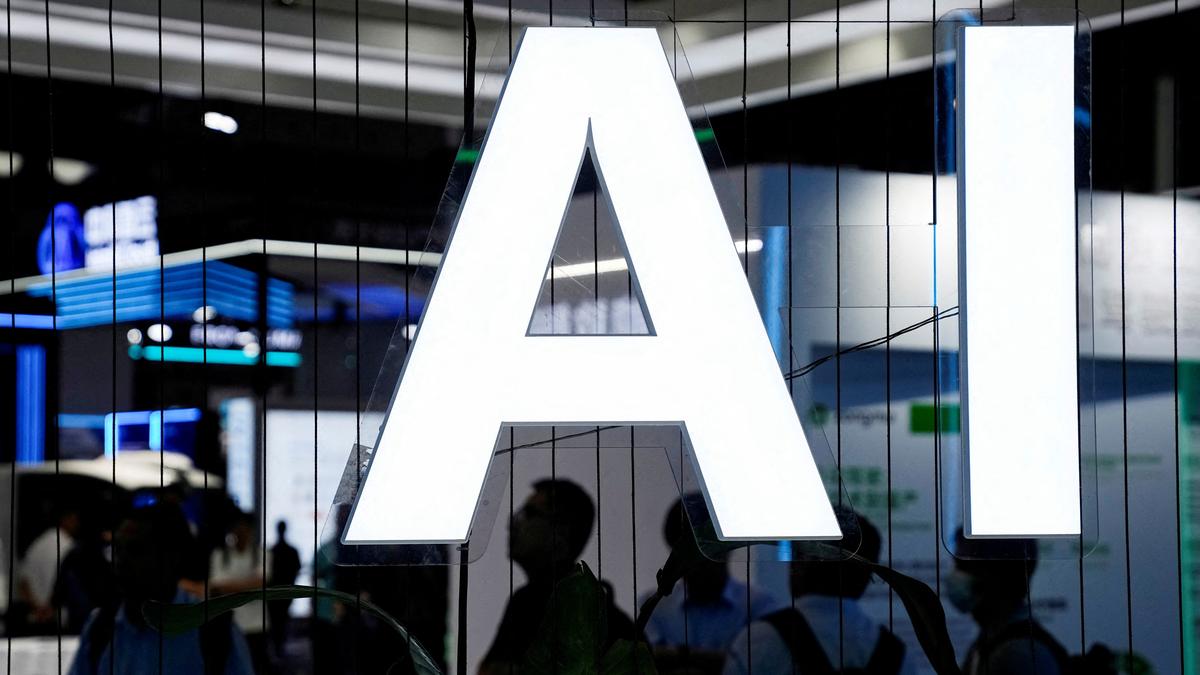
- 08 Feb 2025
In News:
As artificial intelligence (AI) reshapes global economic, strategic, and technological landscapes, the question of whether India should build its own sovereign foundational AI model has gained prominence. Sovereign AI models—developed, trained, and deployed using domestic infrastructure, datasets, and expertise—are now seen as strategic assets, with countries like the US and China already establishing their own. India, however, remains dependent on foreign AI giants such as OpenAI, Google DeepMind, and Meta.
Why India Needs a Sovereign AI Model
1. Data Sovereignty and Security: India generates one of the world’s largest data pools, including sensitive data from healthcare, finance, and governance. Using foreign-built AI models risks privacy breaches and potential misuse. A homegrown model would ensure control over data and ethical AI deployment.
2. Reducing Foreign Dependence: Sovereign AI is crucial for applications in defense, cybersecurity, and governance, where reliance on foreign technology may undermine strategic autonomy. Sanctions or export controls could otherwise disrupt access to essential technologies like GPUs or software updates.
3. Cultural and Linguistic Alignment: Current global AI models are largely English-centric. A sovereign model trained on Indian languages and datasets would bridge the digital divide and make AI more inclusive. Projects like AI4Bharat’s IndicTrans2 and Sarvam AI’s Sarvam-1, a multilingual model built with Nvidia, exemplify this direction.
4. National Security and Innovation: Sovereign AI is essential in military intelligence, predictive security, and surveillance. It also fosters an innovation ecosystem, generating high-skilled jobs and encouraging academic-industry collaboration.
Challenges in Building Foundational AI Models
1. Infrastructure Gaps: India lacks cutting-edge chip manufacturing capabilities. With no agreements with firms like TSMC, India relies on imports of GPUs and processors, unlike countries developing supercomputers (e.g., Denmark’s Gefion, Japan’s AI Grid).
2. High Development Costs: Training a large AI model can cost millions. DeepSeek V3, for instance, cost $5.6 million for a single run, while India’s annual AI R&D budget remains modest compared to Big Tech’s $80 billion.
3. Fragmented Resources: Subsidized GPUs are spread thin across institutions, diluting their impact. Meta’s Llama 4, for example, used large dedicated clusters—unfeasible under current Indian frameworks.
4. Public R&D Inefficiencies: Bureaucratic red tape discourages risk-taking needed in AI research. Unlike flexible spending in firms like OpenAI, Indian R&D lacks autonomy and long-term funding.
Policy Recommendations and Way Forward
- Invest in IndiaAI Mission: Develop a national AI infrastructure with over 10,000 GPUs, secure cloud systems, and supercomputing clusters to train and deploy large-scale models.
- Build DPI for AI Builders: Create datasets, APIs, and platforms to support data annotation, fine-tuning, and delivery in Indian contexts.
- Adopt a Phased Approach: Focus on sovereign models in sensitive sectors (defense, healthcare) while using global open models for non-critical applications.
- Promote Public-Private Collaboration: Forge partnerships with companies like Nvidia or OpenAI for technology transfer and joint ventures.
- Encourage Innovation Under Constraints: India must emulate models like Alibaba or DeepSeek, which succeeded with limited resources and targeted innovations.
Conclusion
Building a sovereign foundational AI model is not merely a technological ambition but a strategic necessity. With coordinated efforts between government, industry, and academia, India can achieve AI self-reliance—ensuring data sovereignty, inclusive growth, and a strong global presence in the AI-driven future.
Satellite Docking Experiment (SpaDeX)
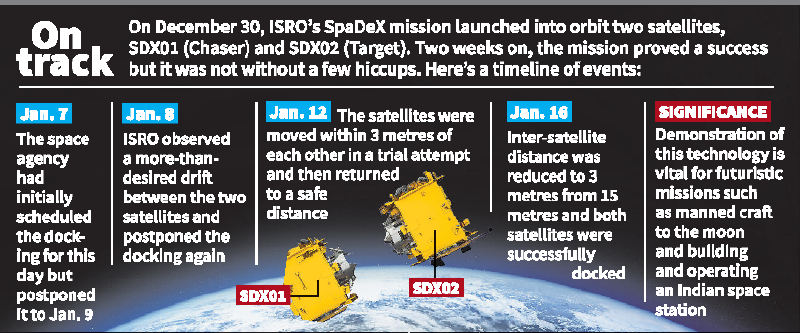
- 17 Jan 2025
In News:
The Indian Space Research Organisation (ISRO) achieved a historic milestone by successfully executing a satellite docking experiment, making India the fourth country after the United States, Russia, and China to accomplish this feat. This advancement represents a significant leap in India's space capabilities, positioning the nation at the forefront of space exploration and in-orbit servicing.
Key Highlights:
- The Space Docking Experiment (SpaDeX) is a critical technological demonstration by ISRO aimed at developing autonomous docking and undocking capabilities in space.
- The mission involves two satellites, SDX01 (Chaser) and SDX02 (Target), which were launched aboard PSLV C60 on December 30, 2024.
- The docking maneuver was overseen by the Mission Operations Complex (MOX) at the ISRO Telemetry, Tracking, and Command Network (ISTRAC) and was successfully completed in the early hours of January 18, 2025.
Key Steps in the Docking Process:
- Manoeuvre from 15m to 3m hold point.
- Precision docking initiation, leading to spacecraft capture.
- Retraction and rigidization for stability.
- Successful control of the docked satellites as a single object.
Significance of the Mission
- Technological Advancement: The docking of two spacecraft in orbit is a crucial capability that paves the way for:
- Autonomous spacecraft operations
- Refueling and maintenance of satellites
- Space station development
- Lunar and interplanetary missions
Future Applications
- Manned Missions: Enables India to develop technology for manned lunar missions and future space station operations.
- Satellite Servicing: Allows repair, maintenance, and extension of satellite lifespan, reducing costs and space debris.
- Sample Return Missions: Essential for lunar and planetary sample retrieval, crucial for deep-space exploration.
Challenges and Overcoming Setbacks
The SpaDeX docking was initially scheduled for January 7, 2025, but was postponed due to the need for further ground validation and an unexpected drift between the satellites. The issue was later resolved, and the docking was executed with precision.
The Road Ahead
Undocking and Power Transfer Demonstration
- ISRO will follow up with power transfer checks between the docked satellites.
- The satellites will later undock and operate separately for the remaining mission duration of up to two years.
Expanding Space Capabilities
- The successful execution of SpaDeX aligns with India’s plans for an independent space station by the 2030s.
- Strengthens India’s position in international space collaborations and commercial space services.
Conclusion
The SpaDeX mission represents a landmark achievement for India’s space program, placing it among the elite nations capable of satellite docking. This breakthrough will serve as a foundation for India’s ambitious future missions, including deep-space exploration, human spaceflight, and interplanetary research. As ISRO continues to develop advanced space technologies, India is set to play a crucial role in the future of global space exploration.
Artificial Solar Eclipse: Why Are Satellites Trying to Block the Sun?
- 14 Dec 2024
Introduction
The European Space Agency (ESA) has launched Proba-3, a mission that will create an artificial solar eclipse to study the Sun's atmosphere, known as the corona. This mission aims to demonstrate new technology and address unresolved questions about the Sun's outer layers.
What is an Artificial Solar Eclipse?
- Definition: An artificial solar eclipse mimics the natural phenomenon where the moon blocks sunlight, allowing detailed observation of the Sun’s corona.
- Created By: The eclipse is created by two satellites, which align to block the Sun's light and generate a controlled shadow for scientific study.
- Purpose: The goal is to study the Sun’s corona, particularly to understand why it is significantly hotter than the Sun’s surface.
How Does the Proba-3 Create an Eclipse?
Launch and Spacecraft
Proba-3 was launched on December 5 from the Satish Dhawan Space Centre in India. The mission uses two satellites:
- Coronagraph Spacecraft (CSC): This spacecraft guides the other satellite.
- Occulter Spacecraft (OSC): This satellite has a disk that creates a controlled shadow onto the CSC.
Formation Flying
Using Precise Formation Flying (PFF) technology, the two spacecraft maintain a precise distance of 150 meters (492 feet) apart, aligning perfectly with the Sun. This alignment mimics the effect of a solar eclipse.
Precision Requirements
The eclipse will need to maintain millimetre-level accuracy for up to six hours per orbit to provide scientists with stable observational conditions.
Mission Goals
- Demonstrating PFF Technology: One of the primary objectives of the Proba-3 mission is to demonstrate PFF technology. This involves using GPS and inter-satellite radio links for positioning, as well as maintaining a precise distance between the two spacecraft.
- Studying the Sun’s Corona: Another goal is to understand why the corona is hotter than the Sun's surface. The onboard instruments, including a coronagraph, will help with this research. The coronagraph will block out the Sun’s bright light, enabling clearer observations of the corona.
- ASPICCS Coronagraph: The Proba-3 coronagraph, named the Association of Spacecraft for Polarimetric and Imaging Investigation of the Corona of the Sun (ASPICCS), is designed to observe the corona in high detail, mimicking the observational conditions of a total solar eclipse.
Why Is This Such a Big Deal?
- Revealing the Sun’s Corona: The Sun’s corona is typically invisible because it is much less bright than the Sun’s surface. It can only be seen during a solar eclipse when the Moon blocks the Sun's light.
- Predicting Space Weather: Studying the corona helps scientists predict space weather and geomagnetic storms, which can disrupt satellites and other systems on Earth.
- Extended Observations: Unlike natural solar eclipses, which last only a few minutes, Proba-3 can provide six hours of observation time in each orbit (approximately 19 hours and 36 minutes), allowing for continuous study of the corona.
What is Precise Formation Flying (PFF) Technology?
- Definition: PFF technology allows satellites to maintain exact positions and orientations relative to each other in orbit.
- Mechanism: The technology uses GPS, inter-satellite radio links, and automated control systems to ensure alignment.
- Implementation in Proba-3: In the Proba-3 mission, the Coronagraph and Occulter spacecraft stay 150 meters apart, using PFF to maintain millimetre-level precision, which is crucial for simulating a solar eclipse.
- Benefits: PFF enhances mission accuracy and provides a platform for advanced observational techniques that will enable more detailed studies of the Sun's corona.
Conclusion
Proba-3 is a groundbreaking mission that will offer unprecedented insights into the Sun’s corona by simulating solar eclipses using advanced satellite technology. By studying the Sun’s outer layers, scientists aim to improve our understanding of space weather and the mysterious temperature anomaly of the corona.
Biomedical Waste Regulations

- 30 Nov 2024
The Emergence of HIV and Global Panic
In 1983, scientists Luc Montagnier and Robert Gallo independently identified the virus responsible for AIDS. By the mid-1980s, HIV/AIDS was perceived as a biological death sentence, with the virus primarily attacking immune cells, making medical intervention difficult. The epidemic quickly became associated with fear, ignorance, and stigma, as it was often linked to marginalized groups.
The "Syringe Tide" Incident and Public Outrage
In August 1987, the U.S. faced a public health crisis when discarded medical waste, including syringes and blood vials, washed up on beaches along the Atlantic coast. Known as the "Syringe Tide," this incident shocked the public and fueled anxiety, especially when children were seen playing with syringes. Traced to improper waste disposal in New York City, the event highlighted the hazardous nature of medical waste, which had been previously underestimated. Combined with the HIV/AIDS epidemic, this incident amplified public fear and economic losses of up to $7.7 billion due to the decline in tourism.
U.S. Response: Medical Waste Tracking Act of 1988
The widespread outrage led to the U.S. government passing the Medical Waste Tracking Act in 1988. This was the first law to formally categorize hospital waste as hazardous. The Act introduced stringent guidelines for the handling, transportation, and disposal of medical waste, establishing systemic regulation and oversight. It marked a significant turning point in both public health and environmental safety, changing how medical waste was managed in the healthcare sector.
India’s Journey in Biomedical Waste Management
Initial Steps and Delays
While the U.S. responded swiftly to the crisis, India’s approach to managing biomedical waste was slower. In 1986, India enacted the Environmental Protection Act, which marked the country’s first significant step towards environmental conservation. That same year, India identified its first HIV case. However, biomedical waste was not yet recognized as hazardous, and the Hazardous Waste (Management and Handling) Rules of 1989 failed to address the issue. As a result, local bodies were left to manage waste disposal, leading to inefficiencies.
Judicial Intervention and Legislative Action
In the 1990s, as pollution levels rose, particularly in urban areas like Delhi, the inadequacies of the system became apparent. In the landmark case Dr. B.L. Wadehra vs. Union of India (1996), the Supreme Court criticized Delhi’s waste management system, calling the city an "open garbage dump." This judgment led to a nationwide conversation on waste management and resulted in the Biomedical Waste (Management and Handling) Rules of 1998, marking the formal recognition of hospital waste as hazardous. The rules empowered the Central and State Pollution Control Boards to regulate waste disposal, ensuring accountability.
The Link Between HIV and Biomedical Waste Regulations
The HIV crisis highlighted the need for safe disposal practices to protect the environment and healthcare workers. While India charted its own course, the global response to HIV, particularly the U.S. model, influenced India’s approach to biomedical waste management. Over the years, India has made significant progress, with amendments to the rules in 2016 and 2020 to improve waste management technology and ensure safe disposal.
Current Challenges and Progress
- Ongoing Issues in Biomedical Waste Management: Despite significant progress, challenges remain, especially in rural and resource-limited areas. Mishandling of biomedical waste continues to pose risks, and healthcare professionals still face occupational hazards. Gaps in compliance and awareness persist, but the system’s progress is undeniable.
Conclusion
The HIV/AIDS epidemic, while tragic, indirectly led to significant improvements in healthcare waste management. As the crisis highlighted the dangers of improper waste disposal, it spurred legislative and systemic changes that have contributed to safer healthcare environments. The progress in biomedical waste management demonstrates that crises can often lead to long-term improvements.
Reimagining Governance with AI: The Promise of GovAI

- 20 Nov 2024
In News:
India's rapid digital transformation, coupled with the advancements in Artificial Intelligence (AI), presents a unique opportunity to reimagine governance. The concept of GovAI—using AI to enhance public administration—holds the potential to revolutionize governance, improve efficiency, and create more responsive and inclusive public systems.
Digital Transformation in Governance
- Evolution of Digital Public Infrastructure (DPI)
- Over the past decade, India has made significant strides in digital governance through the development of Digital Public Infrastructure (DPI). DPI has reduced inefficiencies, enhanced transparency, and improved service delivery, transforming India's governance landscape.
- Impact of AI on Governance
- As AI becomes a critical enabler in various sectors, its application to governance promises to deliver more efficient, inclusive, and responsive government services. The potential of AI lies in its ability to provide more with less, driving innovation across key public services.
Key Trends Driving GovAI
- Rapid Digitalization of India
- Currently, 90 crore Indians are connected to the Internet, with projections indicating 120 crore by 2026, positioning India as the most connected country globally.
- Digitalization serves as the backbone for AI-driven governance, enabling efficient data collection, analysis, and informed policy-making.
- Data as a Valuable Resource
- The rapid digitalization of India has led to the generation of vast amounts of data. This data serves as the fuel for AI models, which can be used to enhance governance.
- Programs like the IndiaDatasetsProgramme aim to harness government datasets for AI development while safeguarding data privacy through legislation.
- Demand for Efficient Governance
- The post-COVID world has underscored the need for governments to deliver better outcomes with fewer resources. AI has the potential to optimize the use of public resources, enabling more efficient and targeted governance.
India’s Leadership in AI-Driven Governance
- Positioning India as a Global Leader
- India’s digital governance initiatives have placed it at the forefront of AI adoption in the public sector. Through GovAI, India can solidify its position as a global leader in using technology for public good.
- As the Chair of the Global Partnership on AI (GPAI), India is advocating for the inclusive development of AI to ensure that it benefits all nations, not just a select few.
- Role of Innovation Ecosystem
- India’s innovation ecosystem, comprising startups, entrepreneurs, and tech hubs, can play a crucial role in driving the development of AI models, platforms, and apps for governance.
- A strong partnership between the government and private sector is essential to successfully deploy AI solutions across various sectors of governance.
Potential Benefits of GovAI
- Enhanced Efficiency and Service Delivery
- AI-powered tools, such as chatbots, can provide citizens with 24/7 assistance, streamlining public service delivery and reducing waiting times.
- AI can help in automating processes and improving the overall efficiency of government operations.
- Data-Driven Decision-Making
- AI can analyze large datasets to make informed policy decisions and design targeted interventions in sectors like healthcare, education, and social welfare.
- Data-driven insights can enhance the effectiveness of welfare schemes, improving outcomes for marginalized communities.
- Increased Transparency and Accountability
- AI can enhance transparency in governance by minimizing human intervention in processes, thus reducing corruption and ensuring efficient use of public resources.
- Predictive analytics and real-time data monitoring can enable proactive governance, preventing issues before they escalate.
Challenges and Drawbacks of GovAI
- Privacy Concerns
- The use of AI in governance requires the collection and analysis of vast amounts of personal data, raising concerns about data privacy and surveillance.
- Robust data protection laws must be enforced to ensure citizens' data is handled responsibly.
- Accountability and Bias
- AI systems may produce biased outcomes depending on the data they are trained on. Ensuring accountability for decisions made by AI systems remains a challenge, particularly when errors or biases occur.
- Transparent mechanisms must be established to hold AI systems accountable for their actions.
- Increased State Control and Surveillance
- The integration of AI in governance could lead to increased state control, potentially compromising individual freedoms. Ensuring that AI is used responsibly to balance power between the government and citizens is critical.
- Digital Divide
- The benefits of AI in governance may not be evenly distributed across the population, exacerbating the digital divide.
- Efforts must be made to ensure that marginalized communities, without access to digital technologies or skills, are not left behind.
Conclusion
- Balancing Benefits and Risks
- The integration of AI into governance systems presents significant benefits, including enhanced efficiency, transparency, and proactive governance. However, there are challenges related to privacy, accountability, and state control.
- To ensure AI serves the public good, India must implement strong regulatory frameworks, promote transparency, and develop ethical AI systems that respect citizens’ rights and freedoms.
- Moving Toward Maximum Governance
- AI can help realize the vision of maximum governance, enabling more effective and targeted interventions across sectors like healthcare, security, education, and disaster management.
- The success of GovAI will depend on a trusted partnership between the government, private sector, and innovation ecosystem, ensuring that AI technology serves the larger public interest.
Significance of LignoSat
- 12 Nov 2024
Introduction
- LignoSat is the world's first satellite constructed with wood, developed to test the viability of using timber as a sustainable material in space exploration.
- Launched on November 5, 2024, the satellite was sent to the International Space Station (ISS) aboard a SpaceX Dragon cargo capsule and will be released into orbit after a month for a six-month test.
What is LignoSat?
- Dimensions: LignoSat measures 4 inches (10 cm) on each side and weighs 900 grams.
- Material Composition: The satellite features panels made from magnolia wood using traditional Japanese craftsmanship, without screws or glue.
- Development Collaboration: LignoSat was developed by Kyoto University and Sumitomo Forestry, in collaboration with various researchers and space organizations.
Purpose and Objectives of the Mission
- Testing Timber in Space:
- The primary goal is to study how wood performs in the extreme conditions of space, where temperatures fluctuate dramatically between -100°C to 100°C.
- The satellite will also assess how wood interacts with space radiation and its potential to reduce the impact of radiation on sensitive electronics, such as semiconductors.
- Space Sustainability:
- LignoSat aims to demonstrate that wood can be a sustainable, renewable alternative to metals (like aluminium) traditionally used in spacecraft construction.
- The satellite will help determine if wood can be used in future space missions, potentially reducing reliance on non-renewable materials.
Testing the Durability of Wood in Space
- Challenges of Space Environment:
- Space is an extremely harsh environment with extreme temperature variations, exposure to radiation, and the lack of water and oxygen, all of which affect material durability.
- Unlike Earth, where wood decomposes due to moisture and oxygen, space's vacuum conditions could potentially preserve the wood's integrity, providing valuable insights into its durability.
- Previous Use of Wood in Space:
- Wood has already been tested in space applications: cork has been used on spacecraft to withstand re-entry conditions.
- The LignoSat mission builds on this knowledge, aiming to test wood's performance in space's high-radiation and vacuum environment.
Potential Advantages of Using Wood in Space Exploration
- Sustainability and Environmental Benefits:
- Unlike conventional aluminium satellites, which generate harmful pollutants upon re-entry (e.g., aluminium oxides), LignoSat's wooden components will degrade in a more environmentally friendly manner, minimizing atmospheric pollution.
- As space exploration increases, particularly with mega-constellations (e.g., SpaceX’s Starlink), space debris management becomes critical. Using wood could reduce the environmental impact of satellite disposal.
- Renewable Resource:
- Wood is a renewable resource, which offers a potential solution to the growing demand for materials used in space technology.
- Kyoto University researchers have long been exploring the idea of building habitats on the Moon and Mars using timber, with LignoSat seen as a stepping stone to proving the material's space-grade capabilities.
LignoSat's Design and Construction
- Hybrid Construction:
- While the outer panels of LignoSat are made from magnolia wood, the satellite still incorporates traditional aluminium structures and electronic components inside.
- The hybrid construction allows researchers to compare the performance of wood against conventional materials used in spacecraft.
- Testing Methods:
- LignoSat will orbit Earth for six months and monitor the wood’s reaction to space conditions, providing valuable data for future space missions.
- Sensors embedded in the satellite will track various environmental factors, such as radiation exposure, temperature fluctuations, and the structural integrity of the wood.
The Long-Term Vision: Building Timber Habitats in Space
- The research team, led by Takao Doi (astronaut and Kyoto University professor), envisions a future where timber is used for constructing space habitats on the Moon and Mars.
- The team’s ultimate goal is to plant trees in space and develop timber houses on extraterrestrial bodies, providing a sustainable, self-sufficient environment for humans in space.
Broader Implications for Space Exploration
- Sustainability in Space Missions:
- LignoSat represents an innovative step toward more sustainable space technologies by investigating eco-friendly materials that can minimize the environmental impact of space missions.
- It aligns with global efforts to make space exploration more sustainable, especially as space tourism and colonization plans grow.
- Future Prospects:
- If successful, LignoSat could pave the way for wood-based materials being used in spacecraft construction, not only for satellites but also for space stations and future human habitats in space.
Conclusion
- LignoSat’s mission marks a significant milestone in space exploration by exploring wood as a sustainable material in space technology.
- As the first wooden satellite, its results could pave the way for more eco-friendly, renewable materials in future space missions, aligning with global goals for sustainability and reducing space-related pollution.
Bharat 6G Mission
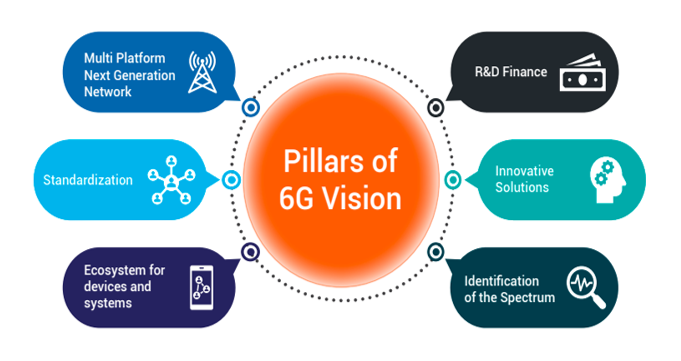
- 10 Nov 2024
In News:
India aspires to lead the world in 6G technology by 2030 through the Bharat 6G Mission. This initiative builds upon the successful rollout of 5G, which reached 98% of districts in just 21 months.
Key Features of 6G Technology
- Terahertz (THz) Frequencies: 6G will utilize THz waves capable of transmitting significantly more data than 5G, offering ultra-fast data rates.
- Massive MIMO (Multiple Input Multiple Output): Supports a large number of devices and simultaneous connections using multiple antennas, improving data transmission and reception.
- Network Slicing: Creates specialized, smaller networks tailored to specific traffic types, such as video streaming or industrial automation.
- Enhanced Security: Incorporates advanced encryption and authentication protocols to safeguard sensitive data.
- Ultra-Reliable Low Latency Communication (URLLC): Ensures ultra-low latency, critical for applications like industrial automation, virtual reality (VR), and augmented reality (AR).
- Integrated Intelligent Reflecting Surfaces (IIRS): Enhances signal strength and quality, particularly in areas with poor reception.
- High-Speed Data Transfer: Supports data communication over hundreds of GHz or THz frequencies, facilitating faster transfer rates.
Government Initiatives for 6G Development
Bharat 6G Vision and Strategy
- Goal: To design, develop, and deploy 6G technologies, ensuring secure, intelligent, and pervasive global connectivity.
- Core Principles:
- Affordability, sustainability, and ubiquity aligned with the vision of Atmanirbhar Bharat (self-reliant India).
- Strategic Objectives:
- Promote R&D through startups, universities, and industries.
- Develop affordable 6G solutions and global IP contributions.
- Focus on transformative applications to enhance quality of life.
Technology Innovation Group (TIG) on 6G
- Established: November 1, 2021.
- Task Forces:
- Focus on multidisciplinary solutions, spectrum management, devices and networks, international standards, and R&D funding.
Bharat 6G Alliance
- A collaborative effort between Indian industry, academia, and research institutions to develop 5G advancements, 6G products, and patents.
- Global Alignment: Partners with organizations like the Next G Alliance (US), 6G Flagship (Finland), and South Korea’s 6G Forum.
Applications of 6G Technology
Application Area
Description
Healthcare
Real-time patient monitoring and AI-connected devices.
Agriculture
IoT and AI-driven predictive systems for crop health and irrigation.
Defense & Internal Security
Enhanced surveillance, communication, and unmanned operations.
Disaster Response
High-volume communication for emergency coordination.
Transportation
Ultra-low latency for urban air mobility and traffic management.
Education
High-speed remote learning, immersive AR/VR-enabled classrooms.
Metaverse
3D holographic displays and seamless virtual interactions.
Industrial Automation
Smart factories with enhanced operational efficiency through real-time data.
Smart Cities
Efficient urban infrastructure and real-time monitoring using IoT.
Entertainment & Media
Higher-quality streaming, immersive content delivery.
Environmental Monitoring
Real-time data collection for resource management and conservation.
Challenges in 6G Development
- Technical Complexity: Development of advanced components and subsystems makes 6G technology highly complex.
- Infrastructure Deployment: Significant investment and regulatory support are required for the necessary infrastructure upgrades.
- Spectrum Allocation: The limited availability of spectrum poses challenges in balancing competing demands for bandwidth.
- Security Concerns: High-speed data transmission increases vulnerability to cyber threats, necessitating robust security protocols.
- Standardization Issues: Achieving global consensus on standards for 6G interoperability can be slow and contentious.
- Global Collaboration: Effective international cooperation is critical for technological and regulatory alignment.
Conclusion
India’s Bharat 6G Mission represents a visionary approach to maintaining technological leadership in the rapidly evolving global digital landscape. By investing in research, fostering international collaborations, and pursuing policies aligned with Atmanirbhar Bharat, India can harness 6G to fuel socio-economic growth and strengthen global connectivity.
The problem with India’s science management (The Hindu)

- 20 Jan 2024
Why is it in the News?
As India remoulds its scientific establishment, the utility of scientists being given administrative tasks needs to be questioned.
Context:
- Sustained economic progress which can satisfy national ambition is invariably fuelled by scientific advances translated into deployable technologies.
- This has been the inevitable global experience since the onset of the Industrial Revolution.
- The government is overhauling India’s science establishment, which includes setting up the new National Research Foundation (NRF) and restructuring the Defence Research and Development Organisation (DRDO).
- In this scenario, a frank assessment of the current administrative ability to simultaneously optimise Indian science’s efficiency and resilience is necessary.
What are the Problems with India’s Scientific Advancement?
India has a long and rich history of scientific innovation. However, in recent years, the country's science management has come under increasing scrutiny. There are several problems with India's science management including:
- Lack of Funding in Research and Development (R&D): One of the most pressing issues is a lack of funding.
- India spends a relatively small percentage of its GDP on research and development, compared to other developed countries.
- For instance, India allocates only about 0.7% of its GDP to R&D, a considerably lower figure compared to global leaders like the United States (3.5%) and China (2.4%).
- This lack of funding has led to a brain drain of talented scientists, who are leaving India in search of better opportunities.
- India spends a relatively small percentage of its GDP on research and development, compared to other developed countries.
- Budgetary Challenges: The modest commitment to R&D stems from broader budget constraints, competing priorities, and a historical emphasis on immediate socio-economic needs.
- This presents a challenge in fostering a robust scientific ecosystem on a limited budget.
- Lack of Coordination: Another problem with India's science management is a lack of coordination.
- There are many different government agencies and departments that are involved in science and technology, but there is often a lack of communication and cooperation between them.
- This can lead to duplication of effort and a waste of resources.
- Inadequacies in Budget Allocation by Scientific Administration: The current scientific administration struggles to identify and invest in high-impact projects.
- For instance, in 2022, the Indian Space Research Organisation ranked eighth in space launches, lagging in key technologies.
- Similar setbacks are evident in nuclear energy, genomics, robotics, and artificial intelligence.
- Lack of Strategic Planning and Execution: Beyond expenditure, the challenge extends to strategic planning and execution of scientific projects.
- Failure to adapt swiftly to emerging technologies and allocate resources judiciously has resulted in India falling behind in crucial fields.
- Inconsistent Long-Term Funding: A major concern is the absence of consistent long-term funding for vital projects, especially when faced with occasional setbacks.
- Steady funding, despite occasional failures, is crucial for a resilient and effective scientific management system.
- Finally, India's science management is often criticized for being too bureaucratic. The process of getting funding for research projects can be long and complex, and it can be difficult for scientists to get the support they need to succeed.
The Role of Senior Scientists in India’s Science Administration:
- Diverse Responsibilities Impacting Focus: Senior scientists in India often juggle multiple responsibilities, including academic pursuits, administrative duties, and leadership positions.
- This dispersion of focus can lead to inefficiencies and a lack of dedicated attention to critical administrative tasks.
- Lack of Administrative Skills: The assumption that successful scientists can seamlessly transition into effective administrators overlooks the distinct skills required for scientific work versus administration.
- Managing institutions, allocating resources, and making organizational decisions demand specific skills not necessarily possessed by accomplished scientists.
- Insufficient Training for Administrative Roles: Inadequate training makes it challenging for scientists to excel in administrative roles.
- Tasks like metric selection, conflict resolution, and setting priorities require skills not inherently developed through scientific training.
- Administration involves translating policy into outcomes, a skill not typically prioritized in scientific training.
- Conflicts of Interest and Quality Control Issues: The dual roles of scientists as academics and administrators can result in conflicts of interest within institutions.
- Academic rivalries, bureaucratic challenges, and compromised quality control may emerge, leading to issues like plagiarism, unethical publication practices, and compromised scientific outcomes.
- Nationwide Transfer System Absence: The absence of a nationwide transfer system for scientists and science administrators exacerbates issues such as competition and egotism.
- The lack of mobility within the system can contribute to internal divisions and hinder the progress of scientific careers and projects.
- Internal Control Challenges: Allowing individuals within the system to regulate it can lead to clear drawbacks, impacting the impartiality and effectiveness of science administration in India.
Challenges in India's Science Administration: A Historical Perspective
- Concentration of High-End Equipment: Economic constraints post-independence led India to concentrate on high-end scientific equipment, notably in institutions like the IITs.
- This concentration birthed gatekeepers, controlling access to critical resources and establishing a hierarchical structure where a few institutions wielded disproportionate influence.
- Gatekeepers and Institutional Captures Concept: Over time, these gatekeepers solidified their positions, accumulating power, government support, and institutional control.
- This system created an environment where young scientists navigated a complex web of influence, paying tributes to those controlling vital resources.
- Impact on Scientific Careers: The gatekeeping system not only influenced resource access but also shaped career trajectories.
- The nexus between institutional power and individual careers became pivotal, with appointments, awards, and international recognition often tied to maintaining favourable relations with gatekeepers.
- Normalization of Unethical Practices: The gatekeeping system has normalized unethical practices within Indian science.
- High plagiarism rates, paid publications in questionable journals, and undisclosed dealings for government funding have become ingrained, compromising the ethical standards of scientific research.
- Stifling Genuine Scientific Outcomes: This erosion of ethical standards doesn't just compromise research quality but stifles genuine scientific outcomes.
- Scientists in conflict with this system face hurdles, hindering promising careers and perpetuating a culture where personal connections often outweigh merit.
A Comparative Analysis of the U.S. Model and Indian Science Administration:
- U.S. Model: In the U.S., scientists chosen for administrative roles are identified early in their careers and undergo targeted training for managerial tasks.
- The emphasis is on maintaining a distinct separation between scientific pursuits and administrative responsibilities.
- Indian Scenario: In contrast, India's science administration traditionally involves senior scientists taking up administrative roles without a clear separation between scientific and administrative functions.
- This integrated approach poses challenges, as the skill sets needed for effective scientific research often differ significantly from those crucial for efficient administration.
Conclusion
As India pursues economic and strategic progress, challenges in science management hinder its research and development, causing a lag in innovation compared to other developed nations. To remedy this, increasing funding for research and development is crucial, along with enhancing coordination among government agencies and streamlining the funding process for research projects. By addressing these issues, India has the potential to emerge as a global leader in science and technology, bringing substantial benefits to its economy and society.
